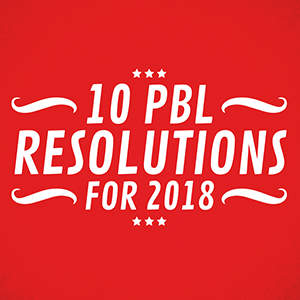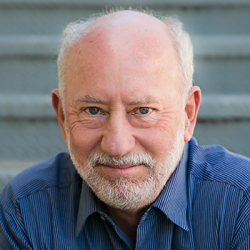 It’s that time of year again—time to resolve to get fit, become a better person, do things you haven’t done enough of… and how about improve your practice of Project Based Learning?
It’s that time of year again—time to resolve to get fit, become a better person, do things you haven’t done enough of… and how about improve your practice of Project Based Learning?
Here are ten resolutions I hope PBL teachers and education leaders can keep in 2018. Some are perennial project design/use issues, and some are curmudgeon-y concerns of mine that have arisen now that PBL has become more popular:
Use PBL regularly for core academic instruction.
I sometimes hear people say they “do PBL” in their school or classroom, then describe their genius hours and maker spaces that students visit a few hours in a school week, or their end-of-year projects after testing is over, or the occasional fund-raising or school culture-building projects. These are fine, as far as they go, but… PBL can be used effectively to teach core content in English Language Arts (including literacy), math, social studies, and science—so let’s see more of it! PBL doesn’t have to be wall-to-wall 24/7, but how about, to start, at least two projects per year for every student?
Use PBL with all students.
We also sometimes hear that PBL should be reserved for students who are gifted and talented, higher skilled, or from suburban schools where the kids don’t need to be drilled and killed with “the basics.” All students deserve the benefits PBL brings, no matter where they live or what their background. (Side note: I know many charter schools, mainly in urban settings, have had success with their highly structured direct instruction approach, as measured by test scores—but can they find ways to add PBL to their programs?)
Try PBL, if you haven’t done so before, by adapting a pre-designed project.
This is a great way to jumpstart your practice of PBL, as Bob Lenz said in this post, by avoiding the common challenges of designing your own projects from scratch and getting a chance to practice being a Project Based Teacher. Look for projects in online libraries such as this one, this one, and this one (and btw BIE will be providing more of these in 2018 and 2019).
Beef up your projects by making them more authentic and rigorous.
Increase student engagement by connecting students with experts, sharing student work with outside audiences, and moving from simulations to real-world projects. Up the quality of student work by holding high expectations and using rubrics, exemplars, and critique protocols. For guidance, use the new High Quality PBL Framework that describes what students should experience in a good project.
Make sure your students are truly engaged by the project.
We hear reports that teachers sometimes try what they think are great projects meeting all the Essential Project Design Elements, but find their students weren’t all that motivated. The problem may be that the topic was owned only by the teacher (e.g., global warming, plastics in the ocean, why Shakespeare is great, etc.) Find out what students are interested in, and/or design projects and entry events that genuinely get them excited/concerned about something.
Teach students how to use project management skills.
One of the most common pitfalls of PBL is managing student teams and the “messy middle” of projects. Students who are not used to working in a PBL environment need to be taught how to: check out this toolkit from the Project Management Institute Educational Foundation, design thinking tools, and this set of resources for building collaboration skills.
Teach students how to make better presentations.
Here’s a common problem that can kill the spirit of a project: ineffective or downright boring presentations. Again, students need to be taught these skills, and not just with a few practice runs a day or two before an exhibition. See this blog post and this post for ideas.
Use PBL practices in your “regular” teaching.
If you’re not quite ready to launch your first project, begin laying the groundwork—for your students and to get used to it yourself—by using driving questions to frame a unit; giving up come control and encouraging more student voice and choice; asking students to conduct inquiry; focusing on real-world applications of content. Many PBL practices are just plain good teaching! See these blog posts about “stepping stones” and the “dimmer switch” approach.
Get serious about teaching, assessing, and reporting on 21st century success skills.
This hope is aimed especially at school and district leaders. If you’ve gone through the exercise of describing your “ideal graduate” who has built skills such as problem solving, collaboration, communication, creativity, and so on, then how are you going to get those outcomes without explicitly and systematically teaching them across the school, assessing them with multiple measures, and making it part of your accountability system? (And, of course, without using PBL?)
Stop calling it “a PBL.”
This has gone from a pet peeve of mine to a real concern, and we’ll be writing a blog post to say more about it soon. A few years ago when I first heard teachers say things like, “We did a PBL last month on the Civil War” the English teacher in me cringed, since you can “do a project” but not “do a Project Based Learning.” Then some colleagues told me not to worry, it was a good sign of PBL’s increasing popularity. But now I fear people are using the term almost like they’re checking off something they had to do, and are not seeing PBL as a profound change in instructional practice. It’s not an event, it’s a methodology.
Best wishes to all for a happy and productive 2018!
Do you have some PBL resolutions for the new year? Please share them in a comment.

